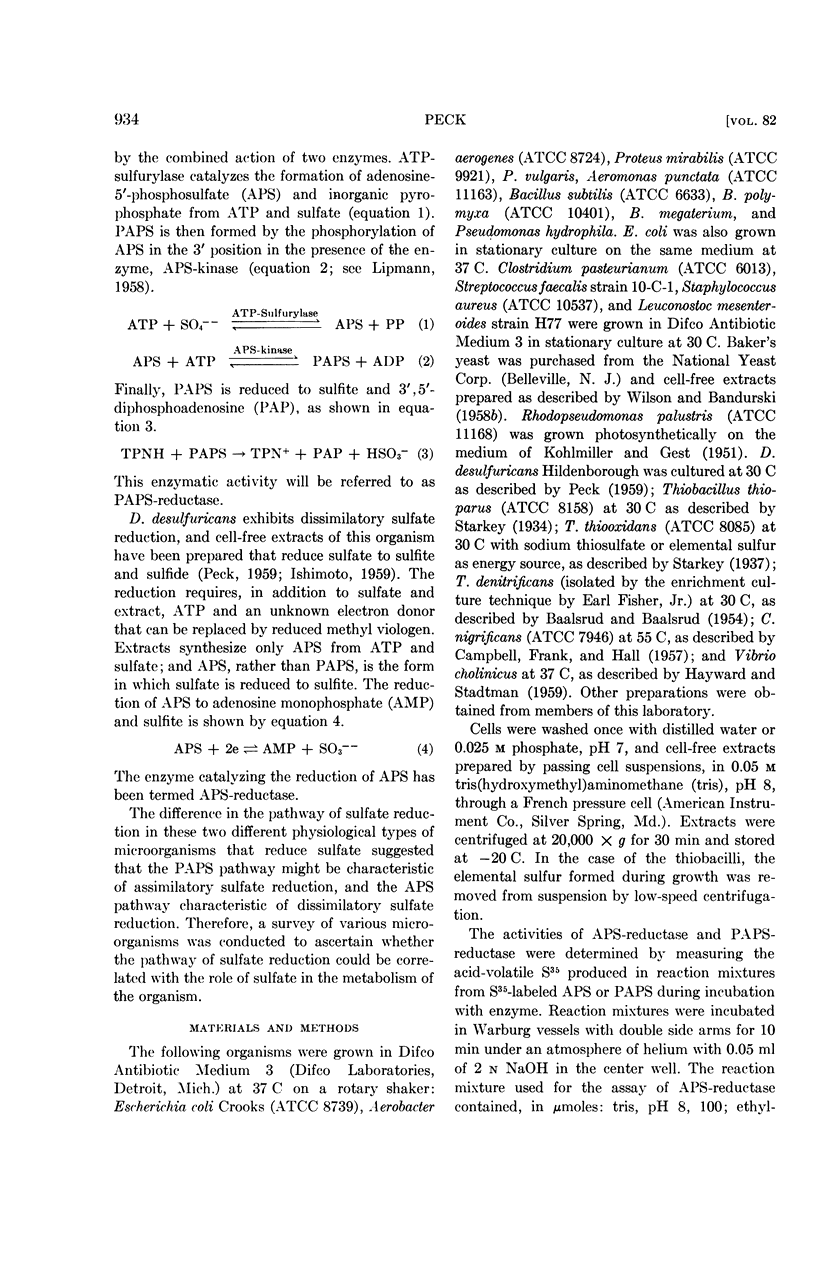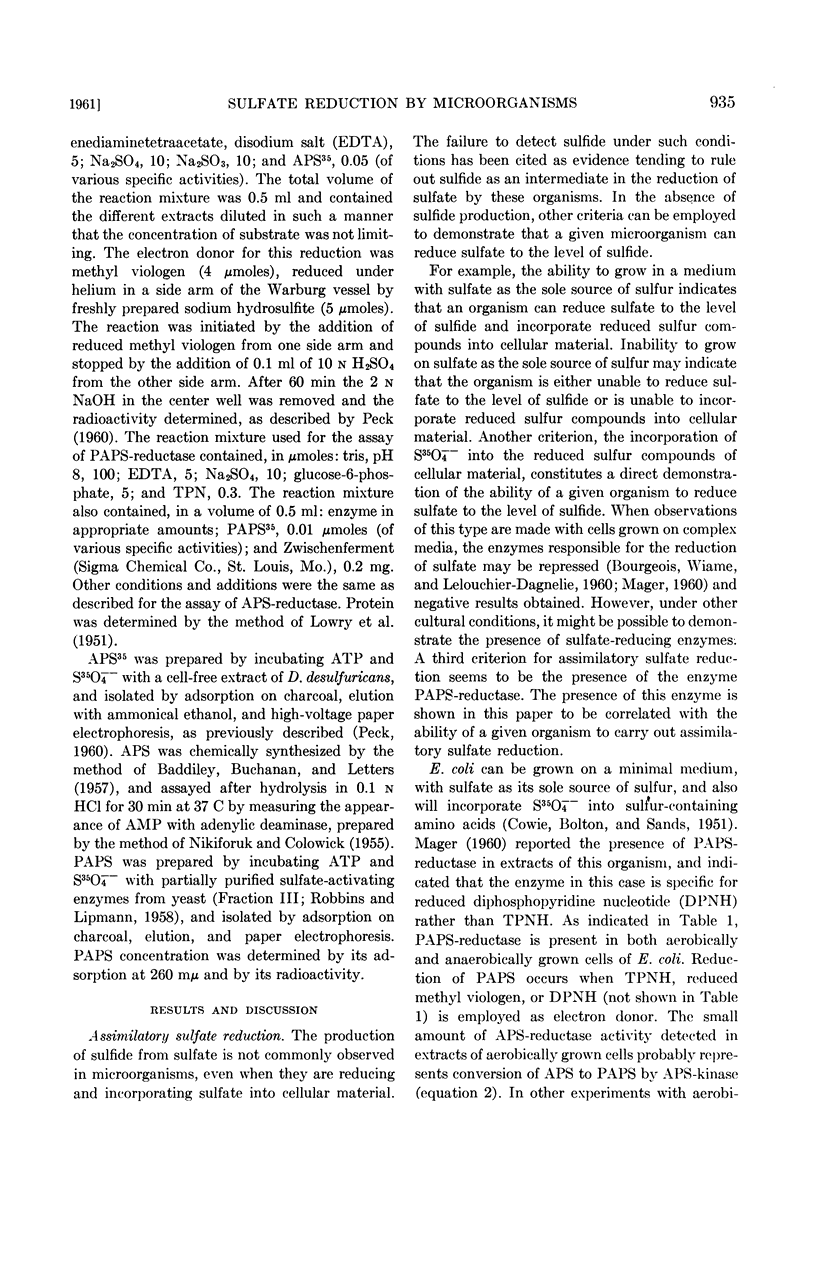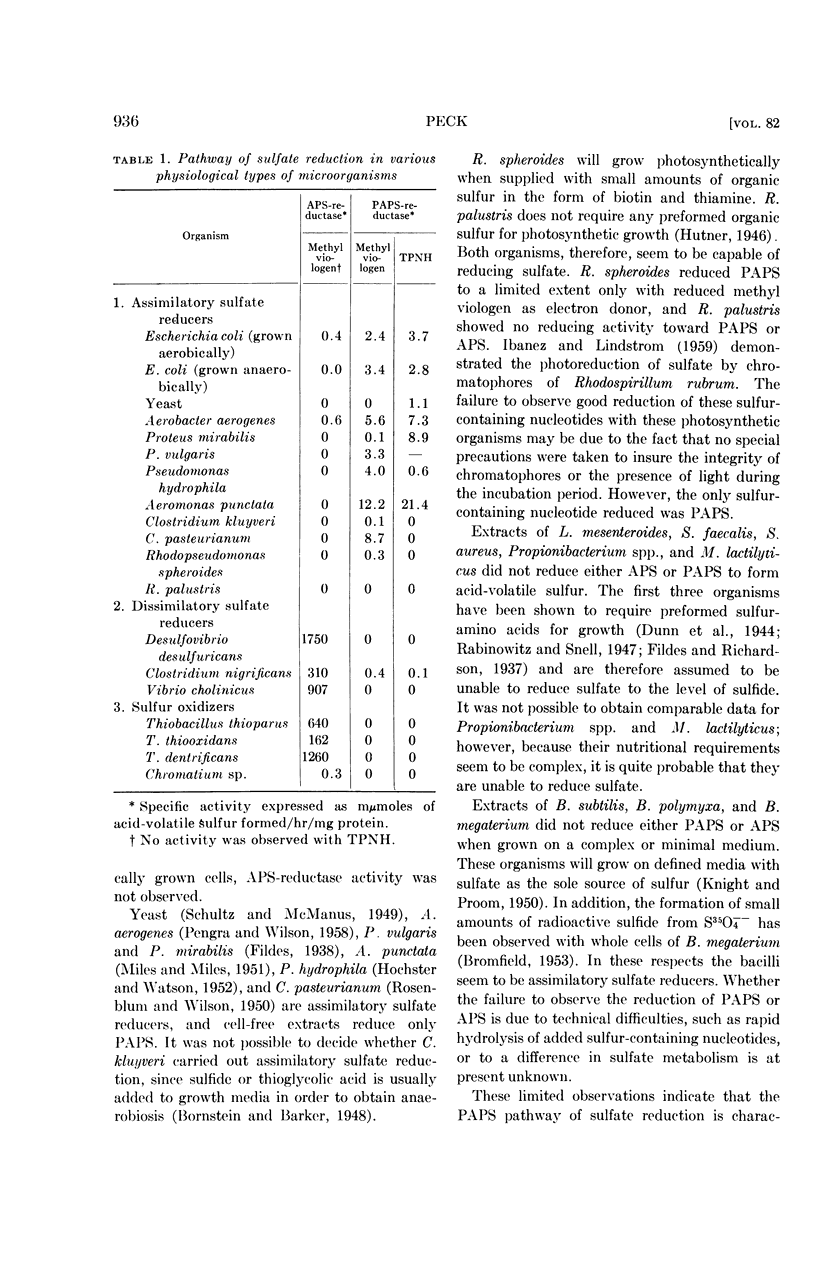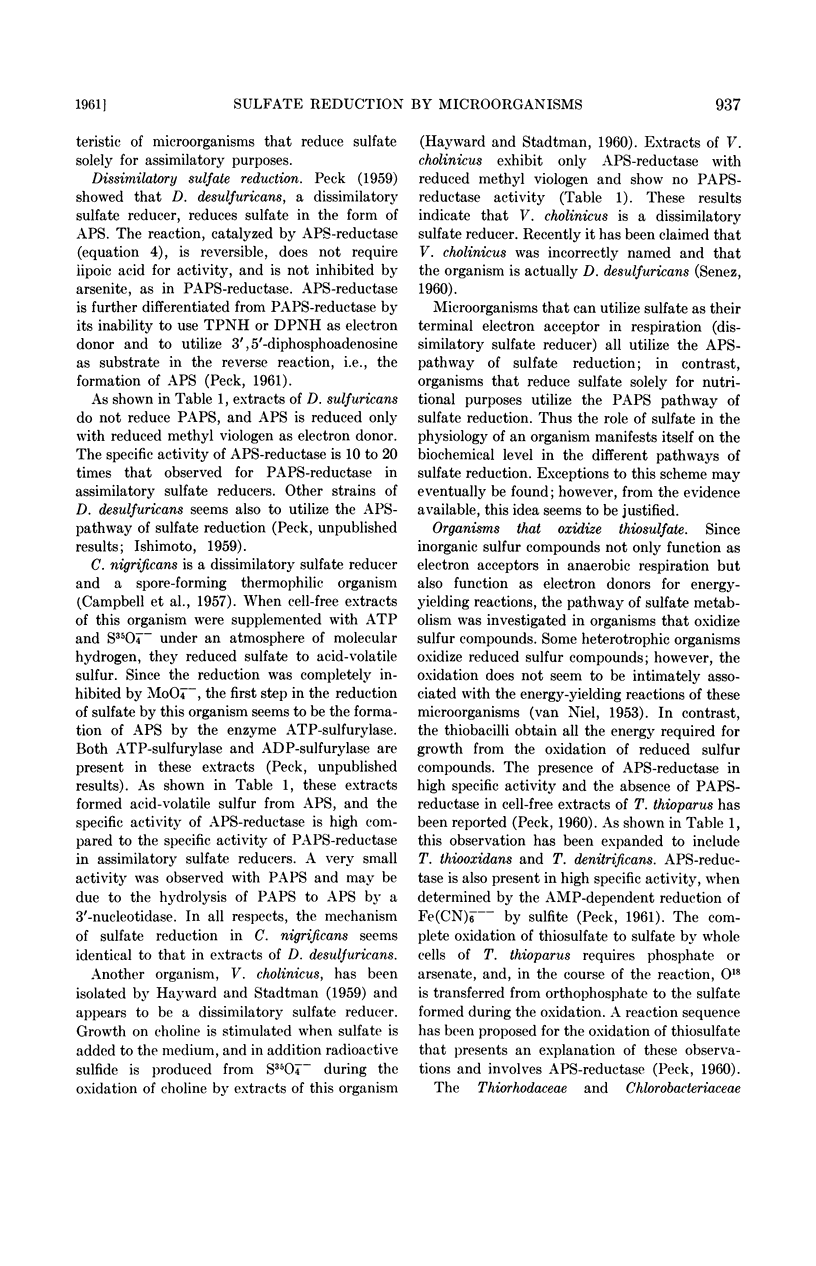Abstract
Peck, H. D., Jr. (Oak Ridge National Laboratory, Oak Ridge, Tenn.). Enzymatic basis for assimilatory and dissimilatory sulfate reduction. J. Bacteriol. 82: 933–939. 1961.—Two pathways for the reduction of sulfate to sulfite in bacteria have been previously described. The substrate for sulfate reduction by extracts of yeast is 3′-phosphoadenosine-5′-phosphosulfate (PAPS) and, in contrast, the substrate for sulfate reduction in extracts of Desulfovibrio desulfuricans is adenosine-5′-phosphosulfate (APS). The enzymes catalyzing these reductions have been termed PAPS-reductase and APS-reductase, respectively. Since yeasts are “assimilatory sulfate reducers”, i.e., reduce only enough sulfate to satisfy nutritional requirements for sulfur, and D. desulfuricans is a “dissimilatory sulfate reducer”, i.e., utilizes sulfate as its terminal electron acceptor in anaerobic respiration, the pathway of sulfate reduction was determined in 25 microorganisms to ascertain whether there is a correlation between the pathway of sulfate reduction and the physiological role of sulfate in the metabolism of bacteria. Assimilatory sulfate reducers reduced sulfate in the form of PAPS, and, with one exception, APS-reductase was found only in dissimilatory sulfate reducers. APS-reductase was also found in the Thiobacilli in high specific activity and is involved in the oxidation of reduced sulfur compounds to sulfate.
Full text
PDF






Selected References
These references are in PubMed. This may not be the complete list of references from this article.
- BAALSRUD K., BAALSRUD K. S. Studies on Thiobacillus denitrificans. Arch Mikrobiol. 1954;20(1):34–62. doi: 10.1007/BF00412265. [DOI] [PubMed] [Google Scholar]
- BOURGEOIS S., WIAME J. M., LELOUCHIER-DAGNELIE H. [Study of the "feedback control" of the synthesis of enzymes by amino acids during the growth of Proteus morganii]. Biochim Biophys Acta. 1960 Feb 12;38:136–144. doi: 10.1016/0006-3002(60)91203-8. [DOI] [PubMed] [Google Scholar]
- BROMFIELD S. M. Sulphate reduction in partially sterilized soil exposed to air. J Gen Microbiol. 1953 Jun;8(3):378–390. doi: 10.1099/00221287-8-3-378. [DOI] [PubMed] [Google Scholar]
- Bornstein B. T., Barker H. A. The Nutrition of Clostridium kluyveri. J Bacteriol. 1948 Feb;55(2):223–230. doi: 10.1128/jb.55.2.223-230.1948. [DOI] [PMC free article] [PubMed] [Google Scholar]
- CAMPBELL L. L., Jr, FRANK H. A., HALL E. R. Studies on thermophilic sulfate reducing bacteria. I. Identification of Sporovibrio desulfuricans as Clostridium nigrificans. J Bacteriol. 1957 Apr;73(4):516–521. doi: 10.1128/jb.73.4.516-521.1957. [DOI] [PMC free article] [PubMed] [Google Scholar]
- COWIE D. B., BOLTON E. T., SANDS M. K. Sulfur metabolism in Escherichia coli. II. Competitive utilization of labeled and nonlabeled sulfur compounds. J Bacteriol. 1951 Jul;62(1):63–74. doi: 10.1128/jb.62.1.63-74.1951. [DOI] [PMC free article] [PubMed] [Google Scholar]
- HAYWARD H. R., STADTMAN T. C. Anaerobic degradation of choline. I. Fermentation of choline by an anaerobic, cytochrome-producing bacterium, Vibrio cholinicus n. sp. J Bacteriol. 1959 Oct;78:557–561. doi: 10.1128/jb.78.4.557-561.1959. [DOI] [PMC free article] [PubMed] [Google Scholar]
- HAYWARD H. R., STADTMAN T. C. Anaerobic degradation of choline. II. Preparation and properties of cell-free extracts of Vibrio cholinicus. J Biol Chem. 1960 Feb;235:538–543. [PubMed] [Google Scholar]
- HENDLEY D. D. Endogenous fermentation in Thiorhodaceae. J Bacteriol. 1955 Dec;70(6):625–634. doi: 10.1128/jb.70.6.625-634.1955. [DOI] [PMC free article] [PubMed] [Google Scholar]
- HILZ H., KITTLER M., KNAPE G. [The reduction of sulfate in yeast]. Biochem Z. 1959;332:151–166. [PubMed] [Google Scholar]
- HILZ H., KITTLER M. Reduction of active sulfate (PAPS) by dihydrolipoic acid as substrate. Biochem Biophys Res Commun. 1960 Aug;3:140–142. doi: 10.1016/0006-291x(60)90209-6. [DOI] [PubMed] [Google Scholar]
- HOCHSTER R. M., WATSON R. W. Phosphorylation of xylose by extracts of Pseudomonas hydrophila. Nature. 1952 Aug 30;170(4322):357–358. doi: 10.1038/170357a0. [DOI] [PubMed] [Google Scholar]
- Hunter S. H. Organic Growth Essentials of the Aerobic Nonsulfur Photosynthetic Bacteria. J Bacteriol. 1946 Aug;52(2):213–221. doi: 10.1128/jb.52.2.213-221.1946. [DOI] [PMC free article] [PubMed] [Google Scholar]
- KNIGHT B. C. J. G., PROOM H. A comparative survey of the nutrition and physiology of mesophilic species in the genus Bacillus. J Gen Microbiol. 1950 Sep;4(3):508–538. doi: 10.1099/00221287-4-3-508. [DOI] [PubMed] [Google Scholar]
- KOHLMILLER E. F., Jr, GEST H. A comparative study of the light and dark fermentations of organic acids by Rhodo-spirillum rubrum. J Bacteriol. 1951 Mar;61(3):269–282. doi: 10.1128/jb.61.3.269-282.1951. [DOI] [PMC free article] [PubMed] [Google Scholar]
- LIPMANN F. Biological sulfate activation and transfer. Science. 1958 Sep 12;128(3324):575–580. doi: 10.1126/science.128.3324.575. [DOI] [PubMed] [Google Scholar]
- LOWRY O. H., ROSEBROUGH N. J., FARR A. L., RANDALL R. J. Protein measurement with the Folin phenol reagent. J Biol Chem. 1951 Nov;193(1):265–275. [PubMed] [Google Scholar]
- MAGER J. A TPNH-linked reductase and its relation to hydroxylamine reductase in Enterobacteriaceae. Biochim Biophys Acta. 1960 Jul 15;41:553–555. doi: 10.1016/0006-3002(60)90065-2. [DOI] [PubMed] [Google Scholar]
- MILES E. M., MILES A. A. The identity of Proteus hydrophilus Bergey et al. and Proteus melanovogenes Miles & Halnan, and their relation to the genus Aeromonas Kluyver & van Niel. J Gen Microbiol. 1951 May;5(2):298–306. doi: 10.1099/00221287-5-2-298. [DOI] [PubMed] [Google Scholar]
- PECK H. D., Jr Evidence for the reversibility of the reaction catalyzed by adenosine 5'-phosphosulfate reductase. Biochim Biophys Acta. 1961 May 27;49:621–624. doi: 10.1016/0006-3002(61)90273-6. [DOI] [PubMed] [Google Scholar]
- PENGRA R. M., WILSON P. W. Physiology of nitrogen fixation by Aerobacter aerogenes. J Bacteriol. 1958 Jan;75(1):21–25. doi: 10.1128/jb.75.1.21-25.1958. [DOI] [PMC free article] [PubMed] [Google Scholar]
- Peck H. D. ADENOSINE 5'-PHOSPHOSULFATE AS AN INTERMEDIATE IN THE OXIDATION OF THIOSULFATE BY THIOBACILLUS THIOPARUS. Proc Natl Acad Sci U S A. 1960 Aug;46(8):1053–1057. doi: 10.1073/pnas.46.8.1053. [DOI] [PMC free article] [PubMed] [Google Scholar]
- Peck H. D. THE ATP-DEPENDENT REDUCTION OF SULFATE WITH HYDROGEN IN EXTRACTS OF DESULFOVIBRIO DESULFURICANS. Proc Natl Acad Sci U S A. 1959 May;45(5):701–708. doi: 10.1073/pnas.45.5.701. [DOI] [PMC free article] [PubMed] [Google Scholar]
- ROBBINS P. W., LIPMANN F. Enzymatic synthesis of adenosine-5'-phosphosulfate. J Biol Chem. 1958 Sep;233(3):686–690. [PubMed] [Google Scholar]
- ROSENBLUM E. D., WILSON P. W. Molecular hydrogen and nitrogen fixation by Clostridium. J Bacteriol. 1950 Jan;59(1):83–91. doi: 10.1128/jb.59.1.83-91.1950. [DOI] [PMC free article] [PubMed] [Google Scholar]
- SCHULTZ A. S., McMANUS D. K. Amino acids and inorganic sulfur as sulfur source for the growth of yeasts. Arch Biochem. 1950 Feb;25(2):401–409. [PubMed] [Google Scholar]
- Starkey R. L. Cultivation of Organisms Concerned in the Oxidation of Thiosulfate. J Bacteriol. 1934 Oct;28(4):365–386. doi: 10.1128/jb.28.4.365-386.1934. [DOI] [PMC free article] [PubMed] [Google Scholar]
- Starkey R. L. Formation of Sulfide by Some Sulfur Bacteria. J Bacteriol. 1937 May;33(5):545–571. doi: 10.1128/jb.33.5.545-571.1937. [DOI] [PMC free article] [PubMed] [Google Scholar]
- Tanner F. W. Studies on the Bacterial Metabolism of Sulfur: I. Formation of Hydrogen Sulfide from Certain Sulfur Compounds Under Aerobic Conditions. J Bacteriol. 1917 Sep;2(5):585–593. doi: 10.1128/jb.2.5.585-593.1917. [DOI] [PMC free article] [PubMed] [Google Scholar]
- VAN NIEL C. B. Introductory remarks on the comparative biochemistry of micro-organisms. J Cell Physiol Suppl. 1953 Mar;41(Suppl 1):11–38. doi: 10.1002/jcp.1030410404. [DOI] [PubMed] [Google Scholar]
- WILSON L. G., BANDURSKI R. S. Enzymatic reactions involving sulfate, sulfite, selenate, and molybdate. J Biol Chem. 1958 Oct;233(4):975–981. [PubMed] [Google Scholar]


